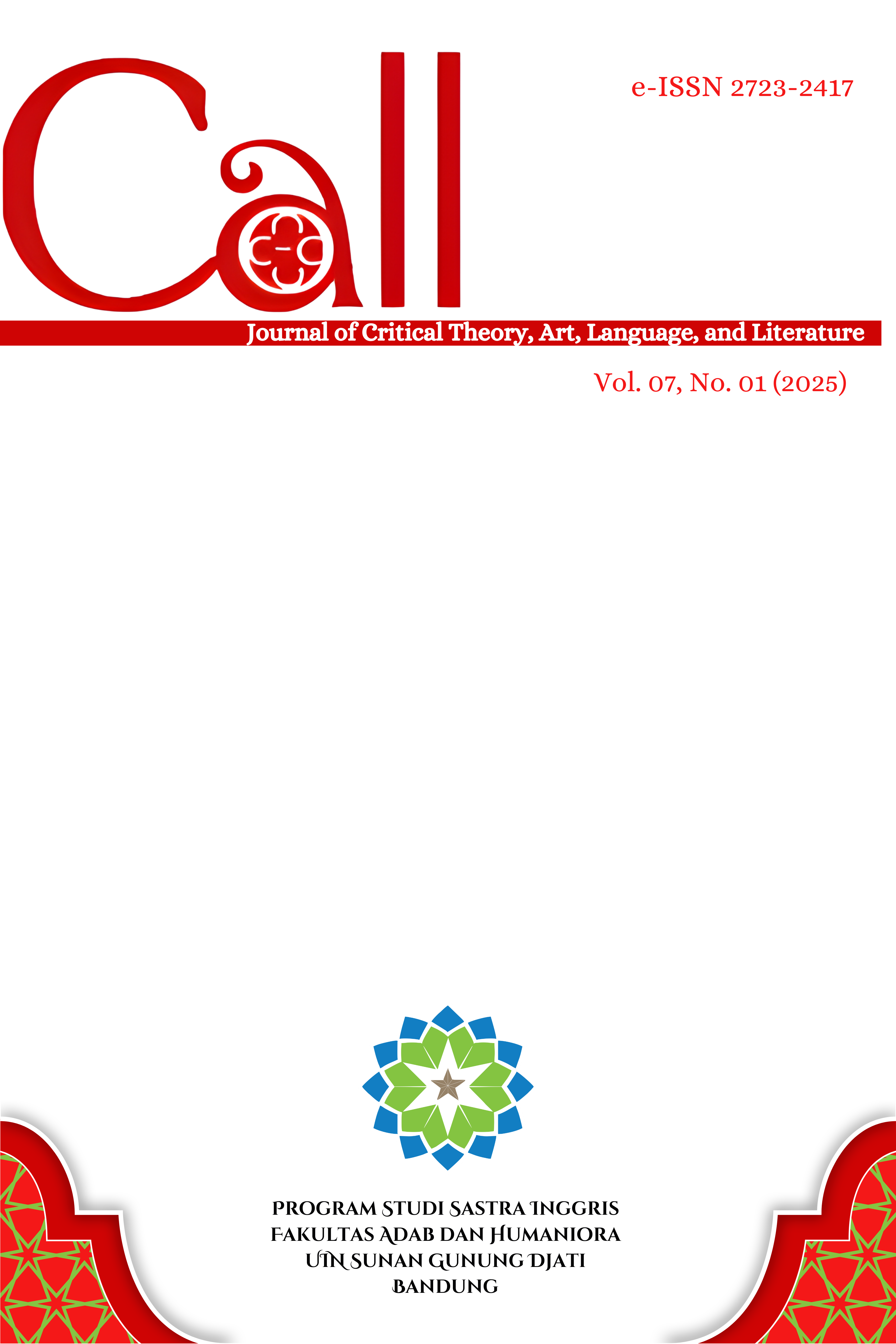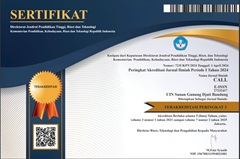DOMINATION, DECEPTION, AND DESTRUCTION: TOXIC MASCULINITY IN DELIA OWENS' WHERE THE CRAWDADS SING
DOI:
https://doi.org/10.15575/call.v7i1.44447Keywords:
domestic violence, power dynamics, toxic masculinityAbstract
The study examines how toxic masculine behaviors are represented in the novel Where the Crawdads Sing by Delia Owens. Using Makhanya's (2023) theory on the hazardous effects of masculinity as a framework, the study focuses on the various forms of toxic masculinity and their impacts on the characters. The findings reveal four types of toxic masculine behaviors in the novel: overcompensation through risky behavior, ineffective conflict resolution strategies, domestic abuse and power dynamics, and sexual assault. Among these, domestic abuse and power dynamics emerge as the most dominant form. The analysis highlights how male characters embody these harmful traits to assert dominance and control, perpetuating cycles of violence and trauma. In conclusion, toxic masculinity operates as a deeply rooted cultural problem, reinforcing patriarchal structures and leaving lasting emotional scars on its victims. This portrayal demonstrates that toxic masculinity is not merely an individual flaw but a systemic issue that perpetuates control, violence, and the silencing of women in both private and public spheres.
References
Arini, P. S., & Nirmalawati, W. (2025). Toxic Masculinity in Short Story: “The Black Cat” and “The Tell-Tale Heart.” Journal of English Language and Education, 10 (1), 41–52. https://doi.org/10.31004/jele.v10i1.590
Ayuretno, A., & Kinasih, P. R. (2024). The Portrayal of Toxic Masculinity on Nate Jacobs in Euphoria ( 2019 ). SALEE: Study of Applied Linguistics and English Education, 5 (2), 508–523. https://doi.org/10.35961/salee.v5i2.1472
Bareket, O., & Shnabel, N. (2020). Domination and Objectification: Men’s Motivation for Dominance Over Women Affects Their Tendency to Sexually Objectify Women. Psychology of Women Quarterly, 44 (1), 28–49. https://doi.org/10.1177/0361684319871913
Başkan, B., & Alkan, Ö. (2023). Determinants of intimate partner controlling behavior targeting women in Türkiye. Frontiers in Psychology, 14 (1), 1–14. https://doi.org/10.3389/fpsyg.2023.1174143
Braly, A. M., Parent, M. C., & DeLucia, P. R. (2018). Do threats to masculinity result in more aggressive driving behavior? Psychology of Men and Masculinity, 19 (4), 540–546. https://doi.org/10.1037/men0000135
Catton, A. K. H., Dorahy, M. J., & Yogeeswaran, K. (2023). Disclosure of Sexual Victimization: Effects of Invalidation and Shame on Re-Disclosure. Journal of Interpersonal Violence, 38 (13–14), 8332–8356. https://doi.org/10.1177/08862605231155122
de Boise, S. (2019). Editorial: is masculinity toxic? Norma: International Journal for Masculinity Studies, 14(3), 147–151. https://doi.org/10.1080/18902138.2019.1654742
Eisend, M. (2019). Gender Roles. Journal of Advertising, 48 (1), 72–80. https://doi.org/10.1080/00913367.2019.1566103
Fahlberg, A., & Pepper, M. (2016). Masculinity and Sexual Violence: Assessing the State of the Field. Sociology Compass, 10 (8), 673–683. https://doi.org/10.1111/soc4.12397
Gray, H. (2021). The Age of Toxicity: The Influence of Gender Roles and Toxic Masculinity in Harmful Heterosexual Relationship Behaviours. Canadian Journal of Family and Youth, 13(3), 41–52. https://doi.org/10.29173/cjfy29621
Hamid, H. B. B. A. (2021). Exploring Victim Blaming Attitudes in Cases of Rape and Sexual Violence: The Relationship with Patriarchy. Malaysian Journal of Social Sciences and Humanities (MJSSH), 6(11), 273–284. https://doi.org/10.47405/mjssh.v6i11.1147
Hernandez, F., & Macaluso, M. (2024). Read like a man: comparing narratives of masculinity in adolescent literature. Frontiers in Sociology, 9 (1), 1–10. https://doi.org/10.3389/fsoc.2024.1329041
Hopkins, M. M., O’Neil, D. A., Bilimoria, D., & Broadfoot, A. (2021). Buried Treasure: Contradictions in the Perception and Reality of Women’s Leadership. Frontiers in Psychology, 12, 1–12. https://doi.org/10.3389/fpsyg.2021.684705
Jones, A., Turner, R. N., & Latu, I. M. (2022). Resistance towards increasing gender diversity in masculine domains: The role of intergroup threat. Group Processes and Intergroup Relations, 25 (3), 24–53. https://doi.org/10.1177/13684302211042424
Kupers, T. A. (2005). Toxic masculinity as a barrier to mental health treatment in prison. Journal of Clinical Psychology, 61 (6), 713–724. https://doi.org/10.1002/jclp.20105
Lennon, S. J., & Johnson, K. K. P. (2021). Men and muscularity research: a review. Fashion and Textiles International Journal of Interdisciplinary Research, 8 (1), 1–21. https://doi.org/10.1186/s40691-021-00245-w
Makhanya, M. (2023). Causes and Consequences of Toxic Masculinity: Can HeForShe Be a Solution for Gender-Based Violence? In F. Bhatti & E. Taheri (Eds.), Gender Inequality - Issues, Challenges and New Perspectives, 1–16. https://doi.org/10.5772/intechopen.110872
Malonda-Vidal, E., Samper-García, P., Llorca-Mestre, A., Muñoz-Navarro, R., & Mestre-Escrivá, V. (2021). Traditional Masculinity and Aggression in Adolescence: Its Relationship with Emotional Processes. International Journal of Environmental Research and Public Health, 18 (18), 1–12. https://doi.org/10.3390/ijerph18189802
Merdassa, A. B. (2024). Traditional masculinity, peer pressure, and sensation seeking as correlates of risky behaviours. International Journal of Adolescence and Youth, 29 (1). https://doi.org/10.1080/02673843.2023.2298087
Mshweshwe, L. (2020). Understanding domestic violence: masculinity, culture, traditions. Heliyon, 6(10), 1–5. https://doi.org/10.1016/j.heliyon.2020.e05334
Nurfitriah, A., Hidayat, S., Sulaeman, K. A., Hariyana, A., & Beresaby, R. A. (2025). Toxic Masculinity in the Jane Campion’s The Power of the Dog. BRIGHT: A Journal of English Language Teaching, Linguistics and Literature, 8 (1), 81–95. https://doi.org/10.29100/bright.v8i1.7178
Owens, D. (2018). Where The Crawdads Sing. G. P. Putnam’s Sons.
Parent, M. C., Gobble, T. D., & Rochlen, A. (2019). Social media behavior, toxic masculinity, and depression. Psychology of Men and Masculinity, 20(3), 277–287. https://doi.org/10.1037/men0000156
Rahayu, A. C., Romadani, A., & Sudarwati, S. (2022). Gender Intervention Through Toxic Masculinity in Hashimi’s The Pearl That Broke Its Shell. Anaphora: Journal of Language, Literary, and Cultural Studies, 5 (1), 84–91. https://doi.org/10.30996/anaphora.v5i1.6638
Rahayu, R., Paturohmah, P. S., & Suyatman, U. (2020). The Roles of Sophie Neveu as Reflection of Women’s Equality in Dan Brown’s The Da Vinci Code Novel. Call, 1(1), 1–8. https://doi.org/10.15575/call.v1i1.8802
Rosen, N. L., & Nofziger, S. (2019). Boys, Bullying, and Gender Roles: How Hegemonic Masculinity Shapes Bullying Behavior. Gender Issues, 36 (3), 295–318. https://doi.org/10.1007/s12147-018-9226-0
Rosida, I., Merdeka, P., Chaliza, A. N., Nisa, A. A., & Sodikin, M. (2022). Toxic Masculinity in Michael Rohrbaugh’s American Male. Litera, 21 (1), 66–80. https://doi.org/10.21831/ltr.v21i1.39792
Sanders, S. M., Garcia-Aguilera, C., Borgogna, N. C., Sy, J. R. T., Comoglio, G., Schultz, O. A. M., & Goldman, J. (2024). The Toxic Masculinity Scale: Development and Initial Validation. Behavioral Sciences, 14 (11), 1–12. https://doi.org/10.3390/bs14111096
Sculos, B. W. (2017). Who’s Afraid of ‘Toxic Masculinity’? Class Race Corporate Power, 5(3), 1–8. https://doi.org/10.25148/crcp.5.3.006517
Siagian, N. N. S. U. (2021). A Portrayal of Toxic Masculinity in Thanos’s Avengers: Endgame. Litera Kultura: Journal of Literary and Cultural Studies, 9 (2), 59–65. https://ejournal.unesa.ac.id/index.php/litera-kultura/article/view/42188
Tredinnick, L., Newman, T., Bosetti, R., Hyzak, K., Reynolds, J., & Weaver, R. (2023). Conformity to Masculine Norms and Attitudes Toward Sexual Behavior: A Study Among College Students Involved in Sport. Sport Social Work Journal, 3 (1), 77–94. https://doi.org/10.33043/sswj.3.1.77-94
Udasmoro, W. (2022). Toxic Masculinities in Post-9/11 Islam-Themed French Novels: Plateforme and Syngué Sabour. Pierre de Patience. K@Ta, 24 (1), 40–48. https://doi.org/10.9744/kata.24.1.40-48
Urcaregui, M. (2023). Book Review: #MeToo and Literary Studies: Reading, Writing, and Teaching about Sexual Violence and Rape Culture by Mary K. Holland and Heather Hewett. Literature & History, 32 (1), 98–100. https://doi.org/10.1177/03061973231186662
Waruwu, A. K., & Wahyuni, D. (2023). Toxic Masculinity Represented in Collen Hoover s It Ends With Us (2016). E-Journal of English Language and Literature, 12 (4), 690–699. https://doi.org/10.24036/ell.v12i4.125747
Yang, J. Y., & Sohn, A. (2022). The Association of Gender Role Attitudes and Risky Drinking: Changes in the Relationship between Masculinity and Drinking in Korean Young Men. International Journal of Environmental Research and Public Health, 19 (21), 1–12. https://doi.org/10.3390/ijerph192114271
Zhao, X., & Roberts, S. (2025). To hell with toxic masculinity?: A case for retaining a debated concept. Journal of Gender Studies, 1–11. https://doi.org/10.1080/09589236.2025.2493260
Downloads
Published
Issue
Section
Citation Check
License
Copyright (c) 2025 I Gusti Ayu Mahatma Agung

This work is licensed under a Creative Commons Attribution-ShareAlike 4.0 International License.
Authors who publish in CALL agree to the following terms:
- Authors retain copyright and grant the journal right of first publication with the work simultaneously licensed under Attribution-ShareAlike 4.0 International (CC BY-SA 4.0) License that allows others to share the work with an acknowledgment of the work's authorship and initial publication in this journal.
- Authors are able to enter into separate, additional contractual arrangements for the non-exclusive distribution of the journal's published version of the work (e.g., post it to an institutional repository or publish it in a book), with an acknowledgment of its initial publication in this journal.
- Authors are permitted and encouraged to post their work online (e.g., in institutional repositories or on their website) prior to and during the submission process, as it can lead to productive exchanges, as well as earlier and greater citation of published work (See The Effect of Open Access).




